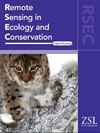应用计算机视觉加速监测和分析鸟类孵化行为:使用普通鹅绒窝摄像机镜头的案例研究
IF 4.3
2区 环境科学与生态学
Q1 ECOLOGY
引用次数: 0
摘要
相机和数据存储技术的进步已经彻底改变了科学家获取大量精细分辨率的野生动物监测数据的能力。这对于鸟类繁殖研究尤其有价值,因为这通常需要持续的鸟巢监测,这可能会持续一个月或更长时间。虽然高质量的图像可能产生有价值的见解,但庞大的数据量可能会造成处理瓶颈。此外,考虑到人工审稿人在数据处理方面的个体水平差异,实现跨项目和年份的一致性是困难的。为了解决这个问题,我们将一个定制的训练过的You Only Look Once version 7 (YOLOv7)模型与StrongSORT跟踪算法配对,以分析从阿拉斯加波弗特海岸的屏障岛上收集的筑巢普通绒鸭(Somateria mollissima)的视频。我们使用计算机视觉管道处理镜头的速度比人工审查快三倍,同时在记录鸟巢出勤率和干扰方面与人类观察者的准确性相匹配。为了评估我们训练有素的流水线的有效性,我们分析了不同年份的新镜头。当鸟在框架中相对较大时,管道的自动化部分表现良好。然而,当相机离鸟巢较远且没有变焦时,占据小帧区域的鸟类的性能下降。当鸟在画面中比较小的时候,它们更容易被镜头上的雨或雾所遮挡,以及被其他在它们前面的鸟所遮挡。此外,在复杂的背景下,探测占据框架一小块区域的鸟类可能更具挑战性,特别是在困难的照明条件下,例如当太阳背光照射鸟类时,或者由于特定的行为,例如当鸟类蹲下以最小化其轮廓以响应感知到的威胁时。为了提高性能,我们建议研究人员在可行的情况下将摄像机放置在离鸟巢更近的地方,或者使用变焦镜头。重要的是,我们的管道设计为物种不可知,允许轻松适应各种筑巢鸟类。本文章由计算机程序翻译,如有差异,请以英文原文为准。
Applying computer vision to accelerate monitoring and analysis of bird incubation behaviors: a case study using common eider nest camera footage
Advances in camera and data storage technology have revolutionized the ability of scientists to acquire large volumes of finely resolved wildlife monitoring data. This is especially valuable for breeding bird research, which often requires and benefits from continuous nest monitoring, which may extend a month or more. Though high‐quality imagery may yield valuable insights, the sheer volume of data can create processing bottlenecks. Furthermore, achieving uniformity across projects and years is difficult given individual‐level differences in data processing by manual reviewers. To address this problem, we paired a custom trained You Only Look Once version 7 (YOLOv7) model with the StrongSORT tracking algorithm to analyze videos of nesting common eiders (Somateria mollissima ) collected from barrier islands along the Beaufort Sea coast in Alaska. We used our computer vision pipeline to process footage three times faster than manual review while matching human observer accuracy in recording nest attendance and disturbances. To evaluate the effectiveness of our trained pipeline, we analyzed novel footage from a different year. The automated part of the pipeline performed well when birds were relatively large in the frame. However, performance declined for birds occupying a small frame area, which occurred when the camera was farther away from the nest and not zoomed. When birds are smaller in the frame, they are more susceptible to being obscured by rain or fog on the lens, as well as by other birds positioned in front of them. Additionally, detecting birds that occupy a small area of the frame can be more challenging in complex backgrounds, particularly under difficult lighting conditions, such as when the sun backlights the bird, or due to specific behaviors, like when birds hunker down to minimize their silhouette in response to perceived threats. To enhance performance, we recommend that researchers position cameras closer to nests whenever feasible or utilize zoom lenses. Importantly, our pipeline is designed to be species‐agnostic, allowing for easy adaptation to various nesting bird species.
求助全文
通过发布文献求助,成功后即可免费获取论文全文。
去求助
来源期刊

Remote Sensing in Ecology and Conservation
Earth and Planetary Sciences-Computers in Earth Sciences
CiteScore
9.80
自引率
5.50%
发文量
69
审稿时长
18 weeks
期刊介绍:
emote Sensing in Ecology and Conservation provides a forum for rapid, peer-reviewed publication of novel, multidisciplinary research at the interface between remote sensing science and ecology and conservation. The journal prioritizes findings that advance the scientific basis of ecology and conservation, promoting the development of remote-sensing based methods relevant to the management of land use and biological systems at all levels, from populations and species to ecosystems and biomes. The journal defines remote sensing in its broadest sense, including data acquisition by hand-held and fixed ground-based sensors, such as camera traps and acoustic recorders, and sensors on airplanes and satellites. The intended journal’s audience includes ecologists, conservation scientists, policy makers, managers of terrestrial and aquatic systems, remote sensing scientists, and students.
Remote Sensing in Ecology and Conservation is a fully open access journal from Wiley and the Zoological Society of London. Remote sensing has enormous potential as to provide information on the state of, and pressures on, biological diversity and ecosystem services, at multiple spatial and temporal scales. This new publication provides a forum for multidisciplinary research in remote sensing science, ecological research and conservation science.
 求助内容:
求助内容: 应助结果提醒方式:
应助结果提醒方式:


